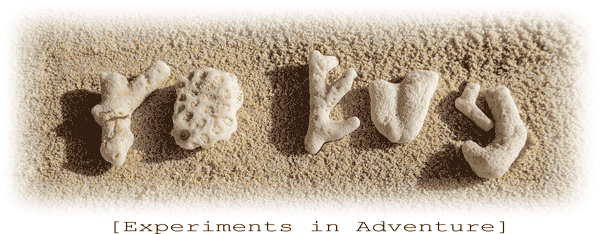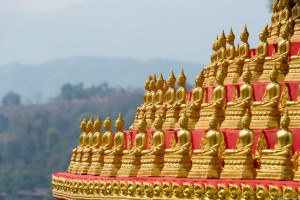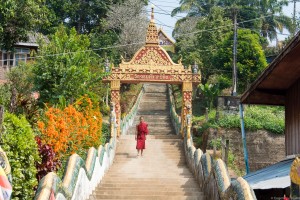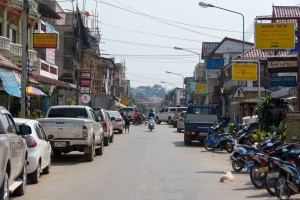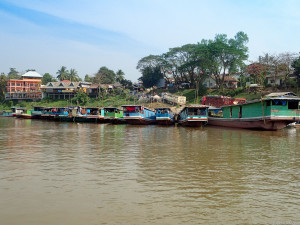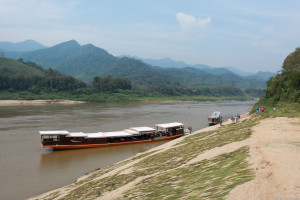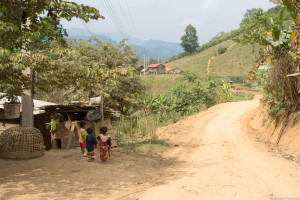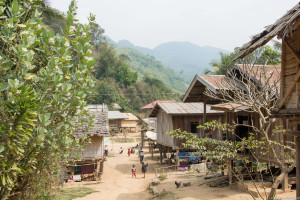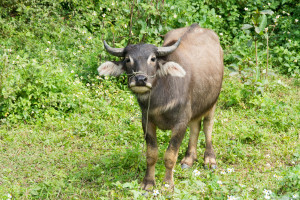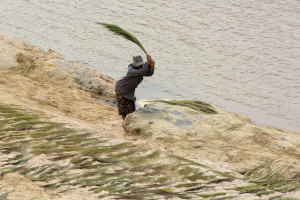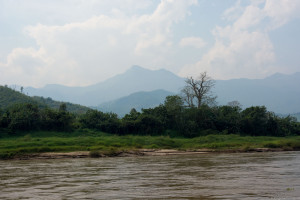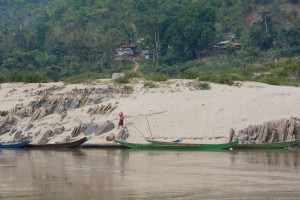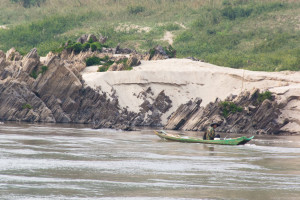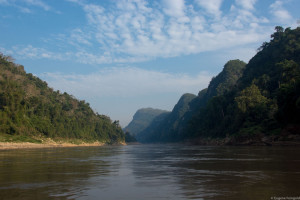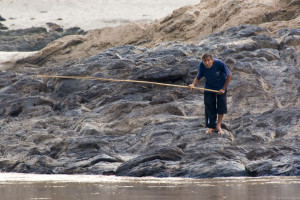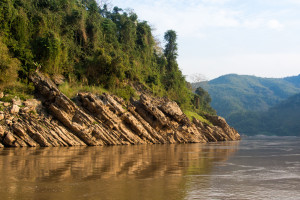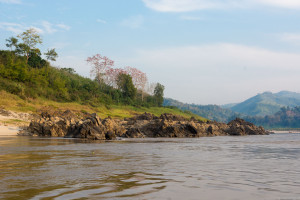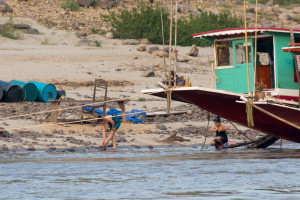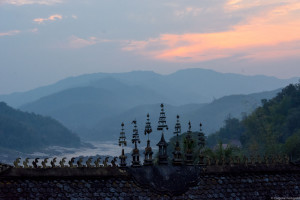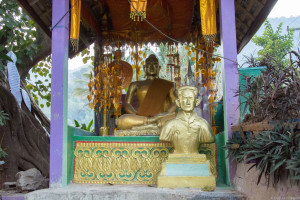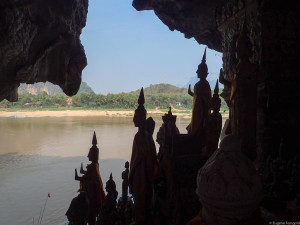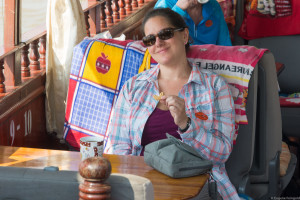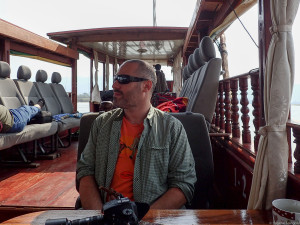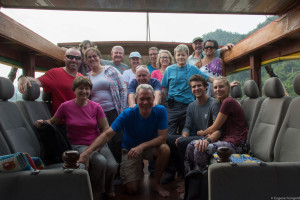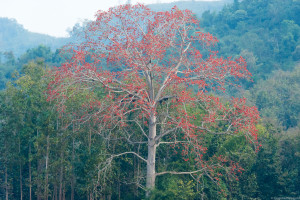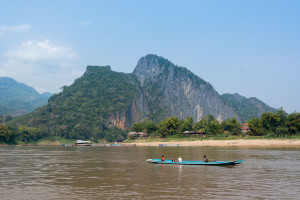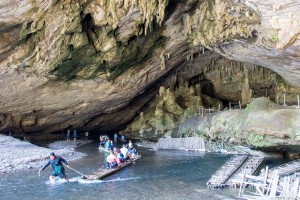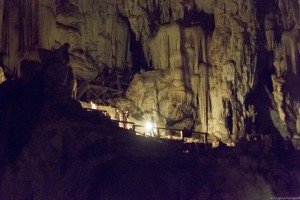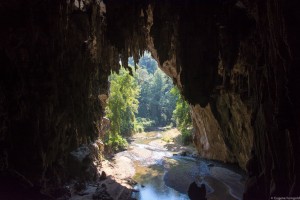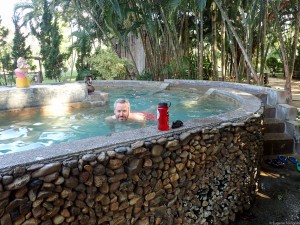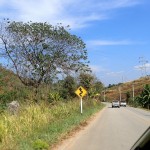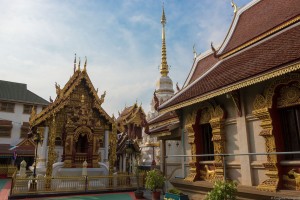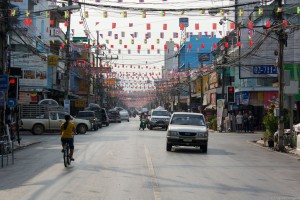When we were first researching where to go in Southeast Asia, I kept reading about taking a boat down the Mekong in Laos. So as our time in Thailand came to close, we began looking into this so-called “slow boat”. We read a few horror stories from taking the cheap slow boats (being stuck with a dead body for 8 hours, for example), but it still seemed like a great way to see the country and relax for a while.
The boat leaves from a Laotian bordertown, about 100 km northeast of Chiang Rai. We made this first leg of our journey by public bus, filled with hungover young backpackers, locals with chickens tucked in their shirts, and packages to be delivered along the way. A Thai woman helped us farang (foreigners) negotiate with the driver to be taken directly to the border crossing, instead of the Thai bordertown 10km away. (Before the bridge was built last year, you simply crossed the river border by boat.) The Thai border guards don’t seem to hold their neighbors in high esteem – when Eugene inquired about where to find the toilet the guard responded “in Laos”.
Once out of Thailand, we had to take a bus across the new Friendship Bridge (no walking!) to Laos. Finally, after getting our visa and another taxi ride, we arrived in the Lao border town, Huay Xia (or Houay Xay or Huoeisay). Laos is noticibly poorer than its Thai neighbor and our time in Huay Xia was unlike any place we’d been in Thailand.
The town itself is not a destination, merely a stop over for those headed to the slow boats or to the Gibbon Experience. Since the boat we’d reserved (a more bourgeois option – Nagi of Mekong – than the often crowded public boats) didn’t leave for a couple days, we got a chance to relax and visit ALL the sites of Huay Xia: the wat, the military base (Eugene got yelled at by a man with a gun while photographing a communist propaganda poster), and a ruined old fort. The wat was definitely less glitzy than those in Thailand, but unlike in Thailand this wat was alive and full of young monks.
- Only men were allowed up on this tower
- Hotel gecko catches a colorful dinner
- Slow boats at the Huay Xia docks
We were more than ready to leave Huoay Xia when the van to our boat picked us up. The slow boats all leave from about a kilometer outside of town and there we met the rest of our boatmates – a dozen or so mainly older couples from the US, Canada, and Europe. The boat was spacious and comfortable, with plenty of space to walk around and look at the scenery from every angle. As the name implies, we slowly made our way down the river and after being served some tasty lunch we stopped at a small native village.
This was an uncomfortable 45 minutes at what Eugene and I now call, “awkward village”. As we walked up the sandy bank, passing women working (men never seem to be doing much), another group of rich white tourists were leaving. So here we were being paraded through the center of town, intruding on the lives of a people who got nothing for being gawked at by us (we left a donation for their “school supplies”, but who knows where that really goes).
Though the town has electricity and satellite TV, they all share a single water pump and mainly subsist off small farms and what they gather in the jungle (some of which is sold to China). One of the guys on our boat had brought candy for the kids in this town, which made it feel even more as if we were treating this visit like a zoo (“aw, look the kid wants another piece of candy”). Worse, judging by the number of empty candy wrappers on the ground, this was not a unique experience.
Trying to ignore my increasing discomfort (and growing “rich western tourist guilt”), I asked the guide more about what life is like for them. He seemed mostly fascinated by the fact that “because they aren’t buddhist” the men can have more than one wife. I desperately wished I could speak their language, but I only knew 3 words in Laotian and that’s not even their first language.
Eugene took only a few photos at Awkward Village, since it already felt so intrusive just being there.
- Docked for a stop at a village
- Even the poorest villages have a satellite dish these days
- “Moo,” said the village buffalo
- They sell these branches for $1/kg to China to make brooms
I was happy when it was time to get back on the boat. The next several hours were spent watching the incredible views go by, occasionally observing life on the river banks, and reflecting about how to be a responsible tourist in places like Awkward Village. Is it better to not visit at all? How do you appropriately interact with people when you have no language in common? Does donating money help or hurt?
The scenery along the Mekong was surprisingly rocky. I was expecting something more like the muddy banks of the Mississippi, but instead it largely a channel carved in rock. Here is just a sampling of what we saw along ride.
- Kids on the banks greeted us with friendly waves
- Bathing is done fully covered in the Mekong
Since the boat ride is 2 full days, everyone stops at the town of Pak Beng for the night. There is not much to the town, but a small wat and a number of guesthouses. We watched the sunset over the Mekong, as the town filled with people from all the other boats. We learned the next day that a few people couldn’t get a room and had to sleep on their boat overnight (we were then glad that our trip included the overnight stay.)
- Sunset from Pak Beng
- Sunset view from a wat in Pak Beng
- Communist wats also pay homage to party leaders
The second day brought many more hours of beautiful scenery. We spent a good amount of the time chatting with our boatmates who were all very friendly and helped us polish off the rice whiskey we’d been given in Sukhothai, Thailand. We made one short stop for “caves”, which we were both excited about after the lovely Thai caves we’d seen. Unfortunately, the Pak Ou caves are 2 small caverns that are filled with hundreds of Buddha figures of all sizes – not particularly exciting.
Finally, in the late afternoon we reached Luang Prabang (more on our time in the former capital soon). The boat was a wonderfully relaxing way to spend 2 days and a great opportunity to observe rural life (except for the actual village stop). It was made all the better by the good group of people with whom we shared the boat.
- From inside the Pak Ou cave
- Happy fellow passengers
